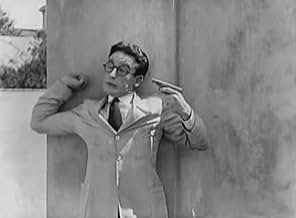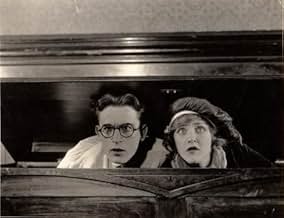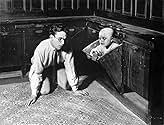अपनी भाषा में प्लॉट जोड़ेंAfter numerous failed attempts to commit suicide, our hero (Lloyd) runs into a lawyer who is looking for a stooge to stand in as a groom in order to secure an inheritance for his client (Dav... सभी पढ़ेंAfter numerous failed attempts to commit suicide, our hero (Lloyd) runs into a lawyer who is looking for a stooge to stand in as a groom in order to secure an inheritance for his client (Davis). The inheritance is a house, which her scheming uncle "haunts" so that he can scare th... सभी पढ़ेंAfter numerous failed attempts to commit suicide, our hero (Lloyd) runs into a lawyer who is looking for a stooge to stand in as a groom in order to secure an inheritance for his client (Davis). The inheritance is a house, which her scheming uncle "haunts" so that he can scare them off and claim the property.
- The Uncle
- (as Wallace Howe)
- Unidentified
- (बिना क्रेडिट के)
- Short Butler
- (बिना क्रेडिट के)
- Woman
- (बिना क्रेडिट के)
- Boy at Robbery
- (बिना क्रेडिट के)
- Bit Role
- (बिना क्रेडिट के)
- The Lawyer
- (बिना क्रेडिट के)
- Gardener
- (बिना क्रेडिट के)
- Kitchen Staff Member
- (बिना क्रेडिट के)
- Fat Butler
- (बिना क्रेडिट के)
- Undetermined Secondary Role
- (बिना क्रेडिट के)
- Bearded Man in Car
- (बिना क्रेडिट के)
- Little Boy
- (बिना क्रेडिट के)
- The Other Girl
- (बिना क्रेडिट के)
- Unidentified role
- (बिना क्रेडिट के)
- Bit Role
- (बिना क्रेडिट के)
फ़ीचर्ड समीक्षाएं
Some racist gags typical of the period can be left aside, what is left is extremely funny, involving people covered in sheets wandering about, boxes which move, and things which go bump. Lloyd and Davis are both delightful and the movie speeds along at a good pace. Recommended.
But before I comment on this hilarious short, I disagree with the fact that this is racist. This is because F Gwynplaine MacIntyre says that the title of this movie is meant to be a racial pun: 'spooks' being a 1920s slang term for Negroes. This is, in my opinion, extremely pointless to note for this when watching this film! This is because that the film's 'spooks' are supposed to be the uncle, played by Wallace Howe, who is trying to scare the Girl, played by Milfred Davies, who has just married to the Boy, played by Lloyd. Therefore, the black servants have nothing to do with scaring them away, because they just hide behind curtains, get covered in flour after jumping in the flour, or hide in a huge pair of trousers, or caught the Uncle in disguise as a ghost!
Now I am going to discuss the film.
First of all, the casting list at the beginning of the film gives the first chuckle from the film by saying that the Girl had 'never-well,only once or twice..' and the Uncle is a 'man of sorts-we are not saying what sort'! Pretty funny... or what?
The Boy's suicide attempts are very funny too. From trying to shot himself with a water pistol, falling off a bridge over shallow water, to falling over another bridge into a boat, it's all great slapstick!
The scene in the mansion where the Boy, the Girl, and the servants run away from the 'spooks', hide behind curtains or in flour or trousers is all hilarious. I could not stop laughing at those antics!
The only criticism I have is the well appropriate score is performed in a midi format. But with a silent film to create mood without music is pretty hard. So there is nothing they could do about it when they released this onto an all-region DVD,which was were I watched it from.
Apart from that, the score for this film is fantastic. I especially enjoyed the piece of music when the Boy and Girl entered into the mansion for the first time. That was a great piece to suit the eerie mood of the place.
Also, I thought the Little Boy, played by Ernest Morrison, almost stole the show by creating the illusion of that table moving, hiding in the flour, which made him look like a ghost when he scrambled out of it, and creating that illusion with the big pair trousers really was hilarious. I was glad that Morrison went on to have a well-establsihed career until his death.
I could not agree with Spuzzum, I do wish Harold Lloyd would get more attention.While Keaton and Chaplin ruled the roost of silent comedies , Harold Lloyd is ignored like that. This is too bad, but he could do it all, prat falls, stuntwork, very subtle comedy and he was a great actor as well. Also nothings justifies this opinion any more then the 5-7 minutes of Haunted Spooks. This is because we see Lloyd as a suitor of a rich socialite competing with another suitor, and in this amazing montage, we see them ducking it out, with Lloyd easily getting the better hand of the frustrated suitor.
Overall, if I was to describe this film in three words they would be very funny indeed!
In Haunted Spooks though we have a film that is ingenious, hilarious and inspired.
From a wonderful introduction to Harold (he's in frame a good 30 seconds before you see him, a truly brilliant reveal) the invention never lets up. The film could easily have sustained 4 reels or more, there is so much going on.
The highlight is a hilarious sequence where Harold, left suicidal by yet another rejection, tries to find ways to do the deed. The result of one attempt involving drowning is priceless and as funny a gag as Lloyd ever produced. Another involving the typical self-absorbed nature of people as a man pauses him in another attempt to ask for a light and then the time while failing to notice the circumstances is equally riotous. It is a gloriously dark vein of comedy for Lloyd, and one he would revisit, that brings to mind Keaton - who often got great fun out of the subject, perfectly demonstrating the fine line between tragedy and comedy.
Here Lloyd does the same perfectly. To so generally happy a character as Lloyd generally portrayed (in contrast to Keaton's more dour screen persona) is ought to be a sad moment (and is one Chaplin would have milked for sentiment) but the triumph of humour over the tragedy is his genius. I know some over-serious types find the subject distasteful but that is to miss the comment which is the fine line between tragedy and comedy, a subject all the finest of the silent comedians (Chaplin, Lloyd, Keaton) understood well and exploited to wonderful effect.
Thankfully the overt ugly and lazy slapstick of violence and chases is largely missing here in favour of genuine laughs and ingenious devices. Bizarrely in the haunted house section of the film there is even a moment that evokes thoughts of FW Murnau's Nosferatu despite the fact that Lloyd's film pre-dates the German masterpiece by 2 years (and it's US premiere by 9).
Mildred Davis, Harold's future wife, is as delightful as always but it is Harold's maturing in comedic styles here that marks this out as a special piece. The only vague marring of the film is a racial stereotyping of the servants in the house - an unfortunate byproduct of the time that seen through modern eyes gains a more negative aspect - but we must remember the time in which the film was made and not judge too harshly for that - in fact Lloyd gives the moment of triumphant discovery to the butler, ably demonstrating his generosity in not always taking centre-stage (in fact Lloyd is missing from probably a quarter of the film entirely).
It is also interesting to note that the accident with a prop bomb which claimed index finger and thumb from his right hand and nearly killed him happened during production of Haunted Spooks, halting production for some months, and the prosthetic glove by wore to disguise this is first evident here. Indeed there are scenes clearly showing his real hand and others with the much lighter in colour prosthetic.
A must see for anyone who not only wants a good laugh but wants to see the mastery of Lloyd at his best in his shorts.
"I thought I would surely be so disabled that I would never be able to work again," Lloyd said years later. "I didn't suppose that I would have one five-hundredth of what I have now. Still I thought, 'Life is worth while. Just to be alive.' I still think so."
With perseverance and a four-month physical rehabilitation, along with a prosthesis glove over the artificial fingers to hide the injury, Lloyd finished "Haunted Spooks," released in March 1920.
The injury didn't stop the comedian from performing his own stunts for his upcoming films, which was especially difficult since he was right handed and the lost fingers were on his right hand. But not once did he complain. And the handicap doesn't show through his post-accident movies, even with him hanging by his fingertips onto the ledge in "High And Dizzy."
It starts off with frequent Lloyd co-star (and future wife) Mildred Davis inheriting an estate - on the condition that she's married and that she stays on the premises for a whole year. Soon, her greedy relatives begin to scheme how to drive her out - but, first, her lawyer determines to find her a husband opting, naturally, on Harold (once again suicidal over a failed romance). This first half provides the film with many of its best moments, as the latter section - relocating to Mississippi - mainly resorts to some crude racist humor and overly familiar ghostly 'manifestations'.
This was my third time viewing the film - the first as an extra on Image's DVD of the Silent version of THE CAT AND THE CANARY (1927) and the second on TCM, as part of a Harold Lloyd marathon in anticipation of the release of this same 7-Disc collection, when I was in Hollywood late last year; actually, I liked it better this time around, hence I upped the rating from **1/2 (besides, back then, I wasn't as familiar with the star's short films as I am now)!
क्या आपको पता है
- ट्रिवियाFilming was interrupted when Harold Lloyd, posing for publicity photos, had a prop bomb explode in his hand. He lost two fingers, his face was badly burned and he was temporarily blinded. In subsequent films, he is always seen wearing a prosthetic glove on his injured hand.
- क्रेज़ी क्रेडिटThe Boy . . . . . . HAROLD LLOYD. He wants to get married - - Has no other faults.
- कनेक्शनFeatured in World of Comedy (1962)
टॉप पसंद
विवरण
- चलने की अवधि25 मिनट
- ध्वनि मिश्रण
- पक्ष अनुपात
- 1.33 : 1
इस पेज में योगदान दें






























